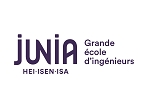Establishment
Language of instruction
French, English
Teaching content
MB-ST
Training officer(s)
AM.KOKOSY, G.TAGNE
Stakeholder(s)
AM.KOKOSY, G.TAGNE, Jean-Yves Dufour (Thales)
Présentation
Prerequisite
None
Goal
Expected skills : 32 (322/323), 34 (342/343), 112 (1122)
The image exhibition is a very vast field which has known an important development for some decades and which still know an important activity, as much research level as industrial application level. The applications are numerous, for example the medical imaging (endoscopy, IRM, tomography, echography and so on…), the air or satellite recognitions, the industrial control, the study of the Earth and the atmosphere, the safety and the multimedia.
Generally we distinguish three main categories of operations:
- The image processing: From an input image, one or several output images are generated.
- The image analysis: From one or several input image, measures are calculated to characterize the images or objects presents in these images.
- The image understanding, also named “computer vision”: From one or several input image, we determine a high-level description more or less complex of the scene (for example: nature of present object, topological relations among these objects, reconstituted depths…)
We can establish an inclusive relation among these categories: the image interpretation requires extracting and characterizing of a set of domains, segments or information more or less local (visible movement at the bottom of the image, object or point) by analysis operations of image. They are based on the application of image processing in the aim to extract from the original image the local information necessary to the application (for example: noise decrease, local characterization for the extraction of contours or domains.)
This course is focused on the fundamental concepts of image processing. Some specific concepts to the image analysis will rapidly be introduced (particularly, characterization of the domain). In contrary, the topic of the interpretation (or rather the “high-levels” operators used for the interpretation) should be the object of one or several specific course and won’t be broached.
The image exhibition is a very vast field which has known an important development for some decades and which still know an important activity, as much research level as industrial application level. The applications are numerous, for example the medical imaging (endoscopy, IRM, tomography, echography and so on…), the air or satellite recognitions, the industrial control, the study of the Earth and the atmosphere, the safety and the multimedia.
Generally we distinguish three main categories of operations:
- The image processing: From an input image, one or several output images are generated.
- The image analysis: From one or several input image, measures are calculated to characterize the images or objects presents in these images.
- The image understanding, also named “computer vision”: From one or several input image, we determine a high-level description more or less complex of the scene (for example: nature of present object, topological relations among these objects, reconstituted depths…)
We can establish an inclusive relation among these categories: the image interpretation requires extracting and characterizing of a set of domains, segments or information more or less local (visible movement at the bottom of the image, object or point) by analysis operations of image. They are based on the application of image processing in the aim to extract from the original image the local information necessary to the application (for example: noise decrease, local characterization for the extraction of contours or domains.)
This course is focused on the fundamental concepts of image processing. Some specific concepts to the image analysis will rapidly be introduced (particularly, characterization of the domain). In contrary, the topic of the interpretation (or rather the “high-levels” operators used for the interpretation) should be the object of one or several specific course and won’t be broached.
Presentation
Introduction, application of images processing
Some definitions and mathematics reminder
Formation and digitalization of image
Digital image (topology, statistics, linear filtration- nonlinear, mathematical morphology)
Restoration and enhancement of images
Segmentation/Characterization, movement analysis
Compression
Some definitions and mathematics reminder
Formation and digitalization of image
Digital image (topology, statistics, linear filtration- nonlinear, mathematical morphology)
Restoration and enhancement of images
Segmentation/Characterization, movement analysis
Compression
Modalités
Forms of instruction
Lesson and practical work
Organization
| Type | Amount of time | Comment | |
|---|---|---|---|
| Face to face | |||
| Lectures - face to face | 14,00 | ||
| Lab | 14,00 | ||
| Independent study | |||
| Independent study | 50,00 | ||
| Overall student workload | 78,00 | ||
Evaluation
Reports of practical work and a final exam
| Control type | Duration | Amount | Weighting |
|---|---|---|---|
| Continuous assessment | |||
| Lab grade | 4,00 | 3 | 75,00 |
| Final Exam | |||
| Written test | 4,00 | 1 | 25,00 |
| TOTAL | 100,00 | ||
Ressources
Bibliography
Le traitement des images - Henri Maître
Hermès - Lavoisier, collection ICC (Information, Commande, Contrôle), 2003
Compression et codage des images et des vidéos - M. Barlaud et de Cl. Labitéditions Hermès Lavoisier, collection ICC, 2003
Analyse d'image: filtrage et segmentation - JP Cocquerez et S. PhilippMasson, 1995
Introduction au traitement d'images: Simulations sous Matlab - Gilles Bureléditions Hermès Lavoisier, 2001
The image processing Handbook - John C. RussCRC Press, 2006






